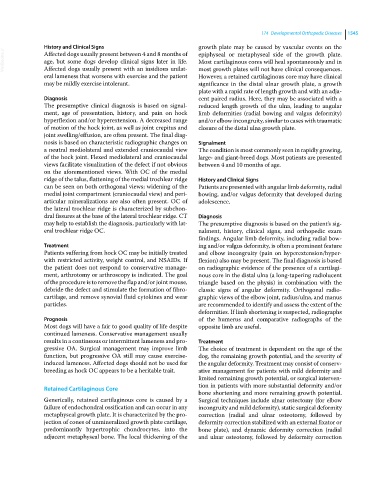Page 1607 - Clinical Small Animal Internal Medicine
P. 1607
174 Developmental Orthopedic Diseases 1545
History and Clinical Signs growth plate may be caused by vascular events on the
VetBooks.ir age, but some dogs develop clinical signs later in life. epiphyseal or metaphyseal side of the growth plate.
Affected dogs usually present between 4 and 8 months of
Most cartilaginous cores will heal spontaneously and in
Affected dogs usually present with an insidious unilat-
However, a retained cartilaginous core may have clinical
eral lameness that worsens with exercise and the patient most growth plates will not have clinical consequences.
may be mildly exercise intolerant. significance in the distal ulnar growth plate, a growth
plate with a rapid rate of length growth and with an adja-
Diagnosis cent paired radius. Here, they may be associated with a
The presumptive clinical diagnosis is based on signal- reduced length growth of the ulna, leading to angular
ment, age of presentation, history, and pain on hock limb deformities (radial bowing and valgus deformity)
hyperflexion and/or hyperextension. A decreased range and/or elbow incongruity, similar to cases with traumatic
of motion of the hock joint, as well as joint crepitus and closure of the distal ulna growth plate.
joint swelling/effusion, are often present. The final diag-
nosis is based on characteristic radiographic changes on Signalment
a neutral mediolateral and extended craniocaudal view The condition is most commonly seen in rapidly growing,
of the hock joint. Flexed mediolateral and craniocaudal large‐ and giant‐breed dogs. Most patients are presented
views facilitate visualization of the defect if not obvious between 4 and 10 months of age.
on the aforementioned views. With OC of the medial
ridge of the talus, flattening of the medial trochlear ridge History and Clinical Signs
can be seen on both orthogonal views; widening of the Patients are presented with angular limb deformity, radial
medial joint compartment (craniocaudal view) and peri- bowing, and/or valgus deformity that developed during
articular mineralizations are also often present. OC of adolescence.
the lateral trochlear ridge is characterized by subchon-
dral fissures at the base of the lateral trochlear ridge. CT Diagnosis
may help to establish the diagnosis, particularly with lat- The presumptive diagnosis is based on the patient’s sig-
eral trochlear ridge OC. nalment, history, clinical signs, and orthopedic exam
findings. Angular limb deformity, including radial bow-
Treatment ing and/or valgus deformity, is often a prominent feature
Patients suffering from hock OC may be initially treated and elbow incongruity (pain on hyperextension/hyper-
with restricted activity, weight control, and NSAIDs. If flexion) also may be present. The final diagnosis is based
the patient does not respond to conservative manage- on radiographic evidence of the presence of a cartilagi-
ment, arthrotomy or arthroscopy is indicated. The goal nous core in the distal ulna (a long‐tapering radiolucent
of the procedure is to remove the flap and/or joint mouse, triangle based on the physis) in combination with the
debride the defect and stimulate the formation of fibro- classic signs of angular deformity. Orthogonal radio-
cartilage, and remove synovial fluid cytokines and wear graphic views of the elbow joint, radius/ulna, and manus
particles. are recommended to identify and assess the extent of the
deformities. If limb shortening is suspected, radiographs
Prognosis of the humerus and comparative radiographs of the
Most dogs will have a fair to good quality of life despite opposite limb are useful.
continued lameness. Conservative management usually
results in a continuous or intermittent lameness and pro- Treatment
gressive OA. Surgical management may improve limb The choice of treatment is dependent on the age of the
function, but progressive OA still may cause exercise‐ dog, the remaining growth potential, and the severity of
induced lameness. Affected dogs should not be used for the angular deformity. Treatment may consist of conserv-
breeding as hock OC appears to be a heritable trait. ative management for patients with mild deformity and
limited remaining growth potential, or surgical interven-
tion in patients with more substantial deformity and/or
Retained Cartilaginous Core
bone shortening and more remaining growth potential.
Generically, retained cartilaginous core is caused by a Surgical techniques include ulnar ostectomy (for elbow
failure of endochondral ossification and can occur in any incongruity and mild deformity), static surgical deformity
metaphyseal growth plate. It is characterized by the pro- correction (radial and ulnar osteotomy, followed by
jection of cones of unmineralized growth plate cartilage, deformity correction stabilized with an external fixator or
predominantly hypertrophic chondrocytes, into the bone plate), and dynamic deformity correction (radial
adjacent metaphyseal bone. The local thickening of the and ulnar osteotomy, followed by deformity correction

